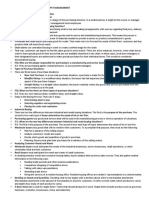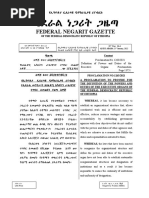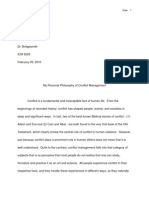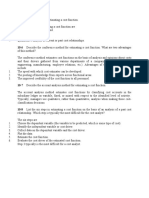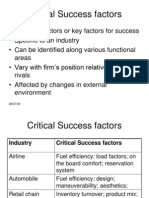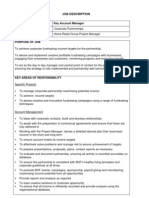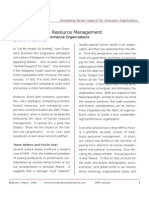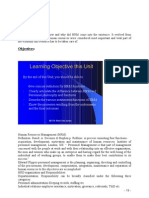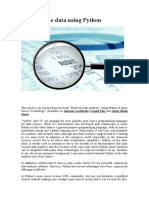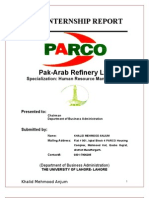Budget: Budgeting Process
Budget: Budgeting Process
Uploaded by
gkmishra2001 at gmail.comCopyright:
Available Formats
Budget: Budgeting Process
Budget: Budgeting Process
Uploaded by
gkmishra2001 at gmail.comOriginal Title
Copyright
Available Formats
Share this document
Did you find this document useful?
Is this content inappropriate?
Copyright:
Available Formats
Budget: Budgeting Process
Budget: Budgeting Process
Uploaded by
gkmishra2001 at gmail.comCopyright:
Available Formats
Management Science-II Prof. R.
Madumathi
MODULE 2
Budget
• Budgets are important tools of profit planning, are similar to the broader
system of planning in an organization.
• Planning involves the specification of the objectives that the organization
will pursue and the fundamental policies that will enable the organization
to achieve the predetermined goals.
Budgeting Process
The Planning/ Budgeting process involves four stages.
They are:
• objective determination stage
• goal determination stages
• strategy formulation stage
• budget preparation stage
Objective Determination Stage
The first stage is setting the ‘Objectives’ which are defined as the
‘broad and long- range desired state or position in the future’.
They are motivational or directional in nature and are expressed in
Qualitative terms.
Goal Determination Stage
The second stage is specifying the goals.
Indian Institute of Technology Madras
Management Science-II Prof. R.Madumathi
The term goal represents targets, specific in quantitative terms to be
achieved in a specific period of time. The timing of introducing new
products, purchase of new plant and machinery and expected rate
of return are examples of time and quantity oriented goals.
Strategy Formulation Stage
The next step involves laying down the strategies.
Strategies denote specific methods or courses of action to achieve
the goals, for instance, promotion of sales through price reduction
or aggressive advertisement and so on.
Indian Institute of Technology Madras
Management Science-II Prof. R.Madumathi
Budget Responsibilities
Types Of Budget
• Sales Budget
• Production Budget
• Purchase Budget
• Expenditure Budgets
• Cash Budget
• Master Budget
• Zero Base Budget
• Flexible Budget
Indian Institute of Technology Madras
Management Science-II Prof. R.Madumathi
Sales Budget
Sales budget is a functional budget. The product wise as well as regional break
up of sales estimates are incorporated in the sales budget. The sales budget
begins with the previous year actual and incorporates the likely changes
Sales Budget – Example
Budget (current Budget Actual (Previous
Area Product
month) (Previous month) month)
Qty. Price Amount Qty. Price Amount Qty. Price Amount
North K1 6000 30 180000 5000 30 150000 5750 30 172500
K2 3250 15 48750 3000 15 45000 3500 15 52500
Total 9250 228750 8000 195000 9250 225500
South K1 1500 30 45000 0 0 0 0 0 0
K2 6500 15 97500 6000 15 90000 6250 15 93750
Total 8000 172500 6000 90000 6250 93750
Production Budget
The production budget is prepared based on the sales estimate incorporated in
the sales budget. The adjustments with respect to the opening and closing stock
positions that are policy decisions of the business are then made to prepare the
production budget.
Indian Institute of Technology Madras
Management Science-II Prof. R.Madumathi
Production Budget – Example
Particulars July August September October November December Total
Sales 1100 1100 1700 1900 2500 2300 10600
Add:Closing
550 850 950 1250 1150 1000 5750
Stock
1650 1950 2650 3150 3650 3300 16350
Less:Opening
550 550 850 950 1250 1150 5300
Stock
Production 1100 1400 1800 2200 2400 2150 11050
Purchase Budget
The purchase budget is another functional budget that estimates the
purchase requirement of materials utilized in the production process. The
purchase budget is based on the production budget and the standard material
consumption requirement for the production estimates.
Indian Institute of Technology Madras
Management Science-II Prof. R.Madumathi
Purchase Budget-Example
Particulars Material A Material B
Qty. Price Qty. Price
Consumption during the year 108000 2 1620000 3
Desired closing stock 13000 2 15000 3
121000 178000
Expected stock at commencement 12000 1.5 15000 1.5
Materials to be purchased 109000 2 163000 2
Expenditure Budgets
Expenditure budgets may be drafted as fixed / flexible budgets. A fixed budget is
one which is prepared keeping in mind one level of activity. It is defined as one
which is designed to remain unchanged irrespective of the level of activity
attained.
In contrast, flexible budget is one which is designed to change in relation
Indian Institute of Technology Madras
Management Science-II Prof. R.Madumathi
to the level of activity attained. Flexible budgets are prepared where the nature
of business is such that it is difficult to predict the demand/sale of goods.
Expenditure Budget – Example
Cost Fixed
Particulars Flexible Budget
behaviour Budget
Capacity 100% 70% 110%
Hours 5000 3500 5500
Wages Variable 2000 1400 2200
Repairs Semi-variable 300 205 370
Rent Fixed 350 350 350
Power Semi-variable 1180 875 1280
Supplies Variable 1200 840 1320
Supervision Semi-variable 950 600 950
Depreciation Semi-variable 650 650 820
Administration Fixed 80 80 80
Selling Semi-variable 150 120 170
Total cost 6860 5120 7545
Hourly rates 1.37 1.46 1.37
Cash Budget
A cash budget consolidates all the cash inflows and outflows for the business.
The cash budget is also a functional budget. The cash budget helps the business
to plan the project purchases as well as to provide for the loan requirements. The
cash budgets also help in defining the repayment plans for short and long term
loans of the business.
Indian Institute of Technology Madras
Management Science-II Prof. R.Madumathi
The cash budget is based upon the business policy of holding a certain amount
as cash. This is the desired opening cash balance for the business. Accordingly,
the cash budget forecasts the loan requirements or short term investments that
are to be made with excess cash at any specific time.
Cash Budget-Example
Particulars April May June Total
Opening Balance 6000 3950 3000 6000
Receipts:
Sales 14650 15650 16650 46950
Dividend income 1000 1000
Vehicle advance 9000 9000
Total balance 20650 28600 20650 62950
Payments:
Creditors (materials) 9600 9000 9200 27800
Salary 3150 3500 3900 10550
Overheads 1950 2100 2250 6300
Plant Installment 2000 2000 2000 6000
Preference dividend 10000 10000
Advance income tax 2000 2000
Total Payments 26700 16600 19350 62650
Closing Balance 3950 3000 300 300
Master Budget
The overall or master budget summarizes the other functional budgets.
Consolidating the functional budgets, an
income and expenditure budget and budgeted balance sheet are prepared. The
master budget is usually a one-year budget expressing the expected asset
position and capital and liability positions for the projected year.
Indian Institute of Technology Madras
Management Science-II Prof. R.Madumathi
Master Budget – Income Statement
Particulars
January February March Total
Sales 12000 15000 10000 37000
Less: cost of goods sold 5000 7000 4300 16300
Factory overheads 2000 2000 2000 6000
Administrative overheads 1000 1000 1000 3000
Selling overheads 500 600 400 1500
Net profit 3500 4400 2300 10200
Master Budget-Balance Sheet
Particulars March Total
January February
Capital 80000 80000 100000 100000
Reserves 15000 17000 18000 18000
Long term borrowings 40000 50000 70000 70000
Total 135000 147000 188000 188000
Fixed assets 86000 93000 120000 120000
current assets 63000 87000 91000 91000
Less:current liabilities 14000 33000 23000 23000
Working capital 49000 54000 68000 68000
Total assets 135000 147000 188000 188000
Indian Institute of Technology Madras
Management Science-II Prof. R.Madumathi
Zero Base Budget
An illustration of a long term budget is the Zero base budget. Zero Base
Budgeting process looks at requirements/ plans anew each year irrespective of
project continuity. These are necessarily long term project budgets.
Variance Analysis
A Variance results from the comparison of the actual with the budgets /
standards / forecasts.
Budget
A budget is a comprehensive financial plan giving the quantitative details for
achieving the financial & operational goals on an organization.
Standards
Standards are expected cost to be incurred under normal efficient operating
conditions.
Forecasts
Forecasts are projected data arrived at using historical data patterns of
quantitative indicators.
Indian Institute of Technology Madras
Management Science-II Prof. R.Madumathi
Variance Analysis
Types Of Variances
• Material variances
• Labor variances
• Overhead variances
• Sales variances
• Margin variances
Material Cost Variance
• Material cost variance represents the difference between the actual
material value and standard material value for a given output.
• The formula for the measurement of material cost variance (MCV) will be:
• MCV = (SP x SQ) - ( AP x AQ)
Where: SP-Standard price, SQ-Standard quantity,
Indian Institute of Technology Madras
Management Science-II Prof. R.Madumathi
• AP-Actual price, AQ-Actual quantity.
Material Price And Usage Variances
• Material price variance captures that part of cost variance which is due to
the difference in price per unit of materials. The formula for the
measurement of material price variance (MPV) will be:
•
MPV = (SP - AP) x AQ.
• Material usage variance is that part of cost variance which is due to the
difference in the utilization of material quantity. The formula for the
measurement of material usage variance (MUV) will be:
•
MUV = (SQ - AQ) x SP.
Where: SP-Standard price, SQ-Standard quantity,
AP-Actual price, AQ-Actual quantity.
Indian Institute of Technology Madras
Management Science-II Prof. R.Madumathi
Material Variance
Material Variance-Example
Indian Institute of Technology Madras
Management Science-II Prof. R.Madumathi
Labor Variance
Labor cost variance represents the difference between the actual labor cost paid
and standard labor cost for a given output.
The formula for the measurement of labor cost variance (LCV) will be:
LCV = (SR x SH) - ( AR x AH)
Where: SR-Standard rate, SH-Standard hours,
AR-Actual rate, AH-Actual hours.
Labor Rate And Efficiency Variances
Labor rate variance captures that part of cost variance which is due to the
difference in wage rate of labor. The formula for the measurement of labor rate
variance (LRV) will be:
LRV = (SR - AR) x AH.
Labor efficiency variance measures that part of cost variance which is due to the
difference in the efficient performance of labor. The formula for the measurement
of labor efficiency variance (LEV) will be:
LEV = (SH - AH) x SR.
Where: SR-Standard rate, SH-Standard hours,
AR-Actual rate, AH-Actual hours.
Indian Institute of Technology Madras
Management Science-II Prof. R.Madumathi
Labor Variance
Overhead Variance
• Overhead variance represents the difference between the actual overhead
cost incurred and standard overhead cost for a given output.
• The formula for the measurement of overhead variance (OV) will be:
•
OV = (Standard overheads) - (Actual overheads)
• Variable overhead variance captures that part of variance which is directly
related to production.
Variable And Fixed Overhead Variances
Variable overhead variance measures the overheads that could be identified as
varying with the output. The formula for the measurement of variable overhead
variance (VOV) will be:
Indian Institute of Technology Madras
Management Science-II Prof. R.Madumathi
VOV = (Standard variable overheads - Actual
variable overheads).
Fixed overhead variance measures that part of overhead variance which does
not alter in a given time context.
The formula for the measurement of fixed overhead variance (FOV) will be:
FOV = (Standard fixed overhead - Actual fixed
overhead).
Overhead Variance
Indian Institute of Technology Madras
Management Science-II Prof. R.Madumathi
Fixed And Variable Overhead Variance –Example
• Fixed overheads: Budgeted Rs.3,000; Actual Rs.3,000
• Variable overheads: Budget Rs.1,500; Actual Rs. 3,000
• Output: Budgeted 3,000 units; Actual 2,500 units
Variable Overhead Variance (Vov)
• Variable overhead variance = (Standard variable overhead -
Actual variable overhead)
VOV = (SVO - AVO) = (2500 x (1500/3000) –
3000
= Rs.1,750
unfavorable.
Fixed Overhead Variance (FOV)
• Fixed overhead variance = (standard fixed overhead - actual
fixed overhead)
FOV = (SOV - AOV) = (2500 x [3000/3000] –
3000
= Rs.500 unfavorable.
• Total Overhead Variance = VOV + FOV = Rs.2,250 unfavorable.
Indian Institute of Technology Madras
Management Science-II Prof. R.Madumathi
Sales Variance
• Sales variance represents the difference between the actual sales
incurred and standard sales.
• The formula for the measurement of sales variance (SLV) will be:
SLV = (BU x BP) - (AU x AP)
where BU-Budgeted units, BP-Budgeted price,
• AU-Actual units, AP-Actual price.
Sales Price And Volume Variances
Sales price variance captures that part of variance which is directly related to
product price. The formula for the measurement of sales price variance (SPV)
will be:
SPV = (BP - AP) x AU.
Sales volume variance measures that part of sales value variance which relates
to the quantity of units sold. The formula for the measurement of sales volume
variance (SVV) will be:
SVV = (BU - AU) x BP.
Indian Institute of Technology Madras
Management Science-II Prof. R.Madumathi
Where BU-Budgeted units, BP-Budgeted price, AU-Actual units, AP-Actual
price.
Sales Variance
Sales Variance-Example
Budgeted Actual
Product
Qty. Price Value Price Value
Qty. (Units)
(Units) (Rs.) (Rs.) (Rs.) (Rs.)
PEE 3,000 2 6,000 2,000 3 6,000
TEE 2,000 3 6,000 4,000 2 8,000
5,000 12,000 6,000 14,000
Indian Institute of Technology Madras
Management Science-II Prof. R.Madumathi
Sales Variance-Example
• Sales variance = (BU X BP) - (AU X AP)
Product PEE = (3,000 X 2) - (2,000 X 3) = 0
Product TEE = (2,000 X 3) - (4,000 x 2) = 2,000 (F)
Total (SLV) = Rs.2,000 (F)
• Sales price variance = (SP - AP) X AU
Product PEE = (2 - 3) X 2,000 = 2,000 (F)
Product TEE = (3 - 2) X 4,000 = 4,000 (UF)
Total (SPV) = Rs.2,000 (UF)
• Sales volume variance = (SU - AU) X SP
Product PEE = (3,000 - 2,000) X 2 = 2,000(UF)
Product TEE = (2,000 - 4,000) X 3 = 6,000 (F)
Total (SVV) = Rs.4,000 (F)
Total Sales variance (SLV) = SPV + SVV = Rs.2,000 (F)
Margin Variance
• Margin variance represents the difference between the actual profit
incurred and standard profit.
• The formula for the measurement of margin variance (MV) will be:
MV = (BU x BPR) - (AU x APR)
where: BU-Budgeted units, BPR-Budgeted Profits,
Indian Institute of Technology Madras
Management Science-II Prof. R.Madumathi
AU-Actual Units, APR-Actual profits.
Margin Rate And Volume Variances
Margin rate variance captures that part of margin variance which is directly
related to product price. The formula for the measurement of margin rate
variance (MRV) will be:
MRV = (BPR - APR) x AU.
Margin volume variance measures that part of margin variance which
relates to the quantity of units sold. The formula for the measurement of margin
volume variance (MVV) will be:
MVV = (BU - AU) x BPR.
Where: BU-Budgeted units, BPR-Budgeted Profits,
AU-Actual Units, APR-Actual profits.
Indian Institute of Technology Madras
Management Science-II Prof. R.Madumathi
Margin Variance-Example
Budget Sales Actual Sales
Product
Qty. Qty.
Price (Rs.) Price (Rs.)
(Units) (Units)
ESS 3,000 40 per unit 5,000 50 per unit
BEE 5,000 20 per unit 4,000 15 per unit
Margin Variance-Example
• Margin variance (MV) = (BU X BPR) - (AU X APR)
Product ESS = (3,000 X 5) - (5,000 X 15) = 60,000 (F)
Product BEE = (5,000 X 8) - (4,000 X 3) = 28,000 (UF)
Total (MV) = Rs.32,000 (F)
• Margin price variance (MPV)= (BPR - APR) x AU
Product ESS = (40 - 50) X 5,000 = 50,000 (F)
Product BEE = (20 - 15) X 4,000 = 20,000 (UF)
Total (MPV) = Rs.30,000 (F)
Indian Institute of Technology Madras
Management Science-II Prof. R.Madumathi
• Margin volume variance (MVV)= (BU - AU) X BPR
Product ESS = (3,000 - 5,000) X 5 = 10,000 (F)
Product BEE = (5,000 - 4,000) X 8 = 8,000 (UF)
Total (MVV) = Rs.2,000 (F)
• Total Margin variance (MV) = MPV + MVV = Rs.32,000 (F)
Indian Institute of Technology Madras
You might also like
- 4 5830107500875094087Document49 pages4 5830107500875094087137samasrNo ratings yet
- Cover Page IGNOU PROJECTDocument1 pageCover Page IGNOU PROJECTgkmishra2001 at gmail.com73% (15)
- Red Flags in Financial StatementsDocument12 pagesRed Flags in Financial StatementsMAツVIcKYツNo ratings yet
- Coursera Supply Chain Planning Week 4 Assignment AnswersDocument6 pagesCoursera Supply Chain Planning Week 4 Assignment AnswersMohammed Soliman MasliNo ratings yet
- BUAD 834 Purchasing & Supply Chain ManagementDocument14 pagesBUAD 834 Purchasing & Supply Chain ManagementDiamond JasmineNo ratings yet
- KM StrategyDocument4 pagesKM StrategyJayb Watua100% (1)
- RCH Business Plan 092009 PDFDocument20 pagesRCH Business Plan 092009 PDFMuhammad Agung Bhagaskoro100% (1)
- Parties & Their Role in Project FinanceDocument15 pagesParties & Their Role in Project FinanceBlesson PerumalNo ratings yet
- Operational Readiness Review A Complete Guide - 2020 EditionFrom EverandOperational Readiness Review A Complete Guide - 2020 EditionNo ratings yet
- Organizational Structure & DesignDocument36 pagesOrganizational Structure & Designgkmishra2001 at gmail.comNo ratings yet
- Human Resource Management Human Resource ManagementDocument267 pagesHuman Resource Management Human Resource Managementgkmishra2001 at gmail.com100% (6)
- MGT Theories & Practices - Ind&group - AssignmentsDocument1 pageMGT Theories & Practices - Ind&group - AssignmentsKalu Aliyi100% (1)
- What Is Finished GoodsDocument5 pagesWhat Is Finished Goodsxin nianNo ratings yet
- ProjectCostManagement MartinGreenhalf PDFDocument53 pagesProjectCostManagement MartinGreenhalf PDFwossenNo ratings yet
- Httpschilot - Mewp Contentuploads202203Proclamation NO. 1263 2021 Definition of Powers and Duties of The Executive OrgansDocument125 pagesHttpschilot - Mewp Contentuploads202203Proclamation NO. 1263 2021 Definition of Powers and Duties of The Executive Organsruth getnetNo ratings yet
- FRS 18, Accounting PoliciesDocument8 pagesFRS 18, Accounting PoliciesveemaswNo ratings yet
- Philosophy of Conflict Management Final Paper 001Document10 pagesPhilosophy of Conflict Management Final Paper 001Andreabg1100% (2)
- Name Four Approaches To Estimating A Cost FunctionDocument1 pageName Four Approaches To Estimating A Cost FunctionElliot RichardNo ratings yet
- What Is An Electronic Filling System ?Document2 pagesWhat Is An Electronic Filling System ?Nabil Ridla Firdaus100% (1)
- Quality in EIARDocument51 pagesQuality in EIAREyob Bezabeh100% (1)
- Mohammed - taju.Id6106.Assighment of QADocument6 pagesMohammed - taju.Id6106.Assighment of QAMohammed Taju TajuNo ratings yet
- Transaction Migration Training MaterialDocument18 pagesTransaction Migration Training MaterialAll EthiopiansNo ratings yet
- Concept of ProfessionDocument7 pagesConcept of ProfessionSyed HyderNo ratings yet
- 32 Project ManagementDocument252 pages32 Project ManagementAjay MalikNo ratings yet
- Strategy and BSCDocument43 pagesStrategy and BSCmulutekleweld60No ratings yet
- Eden Gas StationDocument12 pagesEden Gas Stationhiggu2or10100% (1)
- Guideline 4 Project Adjustment and Re-Appraisal 4Document19 pagesGuideline 4 Project Adjustment and Re-Appraisal 4Ethiopian CitizenNo ratings yet
- Application of Goal Programming in Manufaturing SystemDocument17 pagesApplication of Goal Programming in Manufaturing SystemCboy GamingNo ratings yet
- Management Toughts and Theories: Geleta Merera. (PH.D)Document66 pagesManagement Toughts and Theories: Geleta Merera. (PH.D)abey.mulugeta100% (1)
- Kpi & Kra: Submitted byDocument14 pagesKpi & Kra: Submitted byriddhiNo ratings yet
- M3.1 PPTCitizen's CharterDocument11 pagesM3.1 PPTCitizen's Charterutkarsh100% (1)
- Project Procurement Management: Study NotesDocument16 pagesProject Procurement Management: Study NotesManish Pandey100% (1)
- Qutitative Assignmente 3 AnsewreDocument8 pagesQutitative Assignmente 3 Ansewreabebe amare100% (2)
- Chapter 3 Managerial Accounting PowerPointDocument38 pagesChapter 3 Managerial Accounting PowerPointOmar Bani-KhalafNo ratings yet
- 2023 Audit Final ExamDocument17 pages2023 Audit Final ExamrakutenmeeshoNo ratings yet
- Corporate Governance Practice Landscape in Ethiopia PDFDocument12 pagesCorporate Governance Practice Landscape in Ethiopia PDFAsegid GetachewNo ratings yet
- Strategic Management Chapter 4 External EnvironmentDocument32 pagesStrategic Management Chapter 4 External EnvironmentTesfaye ejetaNo ratings yet
- Research Proposal - CSR - The Voice of The StakeholderDocument13 pagesResearch Proposal - CSR - The Voice of The StakeholderAmany HamzaNo ratings yet
- Strategic Decision MakingDocument15 pagesStrategic Decision MakingMohammad Imran KhanNo ratings yet
- Managment Assignment 1Document5 pagesManagment Assignment 1Fasika AbebeNo ratings yet
- Operations Management - AssignmentDocument6 pagesOperations Management - AssignmentPrashant ThakareNo ratings yet
- GUC ME Assignment IIDocument2 pagesGUC ME Assignment IIEmran Zein100% (1)
- Change Management NotesDocument42 pagesChange Management NotesLinos Tichazorwa100% (1)
- Tank Cleaning Service PDFDocument5 pagesTank Cleaning Service PDFMaaloul Fakher100% (1)
- Generic Key Account Manager JDDocument4 pagesGeneric Key Account Manager JDSamiya AlviNo ratings yet
- New Global Vision College: Addis Ababa CampusDocument5 pagesNew Global Vision College: Addis Ababa CampusMarkonal MulukenNo ratings yet
- What Are The 5 P's of Strategy?Document3 pagesWhat Are The 5 P's of Strategy?Faheem Khan100% (1)
- Foundation of PlanningDocument7 pagesFoundation of Planning27usmanNo ratings yet
- Chapter Four: Compliance AuditingDocument21 pagesChapter Four: Compliance AuditingFackallofyou100% (1)
- Canon 7161 Service ManuelDocument346 pagesCanon 7161 Service ManuelkopisanNo ratings yet
- Oromia State University School of Post Graduate Studies Department of Leadership and Change ManagementDocument19 pagesOromia State University School of Post Graduate Studies Department of Leadership and Change ManagementSimaleeNo ratings yet
- Pharma LinkDocument24 pagesPharma Linkucallmeshweta50% (2)
- Ethiopia Federal Auditor General Establishment Proclamation 2010 (Amendment)Document16 pagesEthiopia Federal Auditor General Establishment Proclamation 2010 (Amendment)anteneh mekonenNo ratings yet
- Ethiopia AmharicDocument40 pagesEthiopia AmharicJemalNo ratings yet
- What Should Be The Fate of The Current Provisions Governing Joint Venture in The Forthcoming Revised Commercial Code of Ethiopia? Retention or Exclusion?Document18 pagesWhat Should Be The Fate of The Current Provisions Governing Joint Venture in The Forthcoming Revised Commercial Code of Ethiopia? Retention or Exclusion?melewon2No ratings yet
- Bule Hora University: Assignment-1: Individual AssignmentDocument8 pagesBule Hora University: Assignment-1: Individual AssignmentMihamedNo ratings yet
- Erp Implementations in Moha Soft Drinks Industry S.C Challenges and ProspectsDocument83 pagesErp Implementations in Moha Soft Drinks Industry S.C Challenges and ProspectsGebiremariam DemisaNo ratings yet
- Assignment of Organizational Behavior: January, 2023 Addis Ababa, EthiopiaDocument10 pagesAssignment of Organizational Behavior: January, 2023 Addis Ababa, Ethiopiatage008100% (1)
- Marketing management-Assignment-IIDocument13 pagesMarketing management-Assignment-IITeke TarekegnNo ratings yet
- With 7" Rear View Mirror Monitor: Owner'ManualDocument2 pagesWith 7" Rear View Mirror Monitor: Owner'ManualFalko Sat100% (1)
- File 3Document77 pagesFile 3Othow Cham AballaNo ratings yet
- Value Chain Management Capability A Complete Guide - 2020 EditionFrom EverandValue Chain Management Capability A Complete Guide - 2020 EditionNo ratings yet
- Types of BudgetDocument2 pagesTypes of Budgetvishalroks50% (2)
- Rubiat Mustak Industrial Management MergedDocument232 pagesRubiat Mustak Industrial Management MergedInkiad ShararNo ratings yet
- Budget (!Document6 pagesBudget (!Timilehin GbengaNo ratings yet
- Certificate of OriginalityDocument1 pageCertificate of Originalitygkmishra2001 at gmail.com100% (1)
- My AcknowledgementDocument1 pageMy Acknowledgementgkmishra2001 at gmail.com100% (1)
- Ms - 100Document10 pagesMs - 100gkmishra2001 at gmail.com100% (1)
- IGNOU Ms 66 AnsDocument17 pagesIGNOU Ms 66 Ansgkmishra2001 at gmail.comNo ratings yet
- Chapter 2 - Various Concepts of MISDocument23 pagesChapter 2 - Various Concepts of MISridhimaamit100% (3)
- Financial TargetsDocument5 pagesFinancial Targetsgkmishra2001 at gmail.comNo ratings yet
- Define Marketing. Distinguish Product Marketing and Services Marketing With SuitableDocument24 pagesDefine Marketing. Distinguish Product Marketing and Services Marketing With Suitablegkmishra2001 at gmail.com50% (2)
- Kruskal WallisDocument13 pagesKruskal Wallisgkmishra2001 at gmail.comNo ratings yet
- MS-9 2010Document9 pagesMS-9 2010gkmishra2001 at gmail.comNo ratings yet
- Database AdministratorDocument2 pagesDatabase Administratorgkmishra2001 at gmail.comNo ratings yet
- The Real EconomyDocument18 pagesThe Real Economygkmishra2001 at gmail.comNo ratings yet
- Database AdministratorDocument2 pagesDatabase Administratorgkmishra2001 at gmail.comNo ratings yet
- Ms 2Document11 pagesMs 2gkmishra2001 at gmail.com100% (11)
- Strategic HRMDocument4 pagesStrategic HRMBibin K Babu0% (1)
- The External EconomyDocument15 pagesThe External Economygkmishra2001 at gmail.com100% (1)
- Ii. Fiscal Situation: Combined Government Finances: 2008-09Document7 pagesIi. Fiscal Situation: Combined Government Finances: 2008-09gkmishra2001 at gmail.comNo ratings yet
- Management Programme: Assignment First Semester 2009Document2 pagesManagement Programme: Assignment First Semester 2009gkmishra2001 at gmail.com100% (8)
- Human Resource PlanningDocument17 pagesHuman Resource Planningritzy.g1745No ratings yet
- HRM in The Next Millennium: ContentDocument61 pagesHRM in The Next Millennium: ContentKartikesh MishraNo ratings yet
- Learning Objective This UnitDocument8 pagesLearning Objective This Unitgkmishra2001 at gmail.comNo ratings yet
- Comprehensive Study of Research School Discipline Issues in The OECSDocument42 pagesComprehensive Study of Research School Discipline Issues in The OECSgkmishra2001 at gmail.com100% (2)
- The Process of Performance ManagementDocument15 pagesThe Process of Performance Managementgkmishra2001 at gmail.comNo ratings yet
- Lesson-13 Staffing - Introduction To Human Resource Management, Planning and Planning ProcessDocument5 pagesLesson-13 Staffing - Introduction To Human Resource Management, Planning and Planning Processgkmishra2001 at gmail.comNo ratings yet
- Auditing The Data Using PythonDocument4 pagesAuditing The Data Using PythonMarcos TotiNo ratings yet
- BBA 305 - Production Management-Notes 1Document15 pagesBBA 305 - Production Management-Notes 1Snehash Sinha67% (6)
- Quantitative Techniques in Decision MakingDocument41 pagesQuantitative Techniques in Decision MakinganngeiballosNo ratings yet
- AI and Data ScienceDocument12 pagesAI and Data ScienceNicah AcojonNo ratings yet
- Business Eco PDFDocument6 pagesBusiness Eco PDFpooja mandalNo ratings yet
- Six Sigma Methodology With Fraud Detection: 1 Applications of Data MiningDocument4 pagesSix Sigma Methodology With Fraud Detection: 1 Applications of Data MiningKanika SharmaNo ratings yet
- IBP Strategy Update 2023 Q3Document44 pagesIBP Strategy Update 2023 Q3arunv1974No ratings yet
- Project Preparation: Unit FourDocument37 pagesProject Preparation: Unit FourTemesgen100% (1)
- Techniques of Demand ForecastingDocument19 pagesTechniques of Demand ForecastingBhanuprasad sridharaNo ratings yet
- Financial Forecasting: Dr. Eduardo AñonuevoDocument47 pagesFinancial Forecasting: Dr. Eduardo AñonuevoEduardo AñonuevoNo ratings yet
- Chowdhury 2005Document10 pagesChowdhury 2005Sourov paulNo ratings yet
- Time Series Prediction ThesisDocument8 pagesTime Series Prediction Thesislidzckikd100% (2)
- DaburDocument2 pagesDaburAnil GuptaNo ratings yet
- Predictions in Soil EngineeringDocument52 pagesPredictions in Soil Engineeringxieyn100% (1)
- Amity School of Business: BBA V Semester Sales and Distribution ManagementDocument26 pagesAmity School of Business: BBA V Semester Sales and Distribution ManagementRishabh DhharNo ratings yet
- Khalid Mehmood Anjum Internship Report MBA UOLDocument110 pagesKhalid Mehmood Anjum Internship Report MBA UOLTaimur FazilNo ratings yet
- 2019 Book UnderstandingTheRoleOfBusinessDocument217 pages2019 Book UnderstandingTheRoleOfBusinessSaid100% (1)
- 978 0133507331 Quantitative Analysis For Management 12th EditionDocument61 pages978 0133507331 Quantitative Analysis For Management 12th Editionbryant.laverty122100% (57)
- Manual For Virtual Grower 3 - 0Document52 pagesManual For Virtual Grower 3 - 0Juber DelgadilloNo ratings yet
- IEEE Report of BTPDocument10 pagesIEEE Report of BTPSriharsha MareeduNo ratings yet
- Aggregate Production Planning - Lecture NotesDocument16 pagesAggregate Production Planning - Lecture NotesJim Mathilakathu100% (2)
- Assignment 2 SolutionDocument4 pagesAssignment 2 SolutionshwetapooranibalasubramanianNo ratings yet
- A Guide To Using Artificial Intelligence in The Public SectorDocument48 pagesA Guide To Using Artificial Intelligence in The Public SectorFabián GarófaloNo ratings yet
- Operations AnalyticsDocument2 pagesOperations AnalyticsajinkyapolNo ratings yet
- How To Trend ForecastDocument25 pagesHow To Trend ForecastVasudha PantNo ratings yet
- Chap 011Document38 pagesChap 011Loser NeetNo ratings yet
- Corporate Cash and Liquidity Management PoVDocument12 pagesCorporate Cash and Liquidity Management PoVdeepanshuNo ratings yet
- Programa Tecnolgico de MonterreyDocument6 pagesPrograma Tecnolgico de MonterreysenchiNo ratings yet




